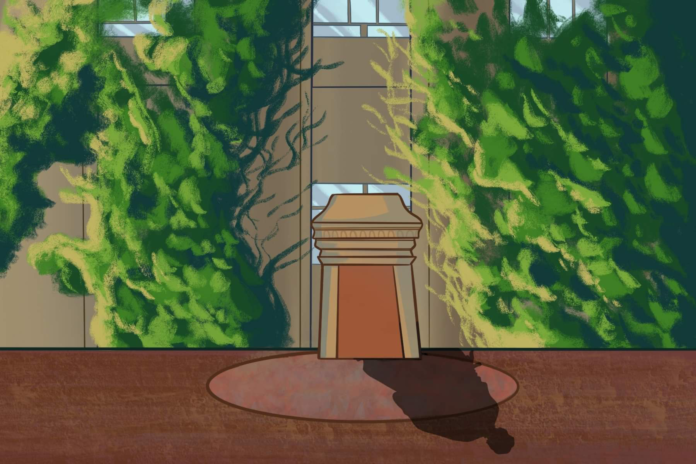
After years of students petitioning to take down a controversial statue on Ryerson University’s campus, the university announced a task force to examine Egerton Ryerson’s history and relationship to the school.
According to a statement from Ryerson released on Sept. 2, the task force will consist of Ryerson experts, students, and alumni. It will gather feedback on what the university can do to reconcile the history of Egerton Ryerson, and submit a final report with recommended actions regarding the statue.
The announcement comes in response to a more recent and popular petition started by a student in June, which called for the removal of Egerton Ryerson’s statue on the downtown campus.
The petition, which has almost 10,000 signatures, has drawn attention to the controversial history of Egerton Ryerson, who played a role in the establishment of residential schools in Canada.
Maaz Khan, the creator of the June petition, said he believes the petition played an integral part in the creation of the university’s task force.
“[The petition] showed them that thousands of students and community members want this statue gone,” Khan said.
Born in 1803, Egerton Ryerson was Ontario’s first superintendent of education. Ryerson was also instrumental in establishing residential schools in Canada, a system that oppressed and aimed to assimilate 150,000 Indigenous children across Canada into Euro-Canadian society.
In July, protesters defaced the Ryerson statue, with pink paint and a sign that read, “Tear down monuments that represent slavery, colonialism, and violence.”
Khan, the creator of June’s petition, is a former Ryerson student and recent graduate from Ryerson’s business technology management program. He participated in multiple movements to remove the statue throughout his career at Ryerson.
In 2017, Khan was involved in efforts by the Ryerson Student Union demanding the removal of the statue and that the school change its name, though these initiatives did not lead to any significant changes.
Despite dozens of movements across Canadian university campuses urging for the removal of controversial statues, some argue Canadians should honour their history and the figures they believe shaped their country.
Others, including Khan, disagree.
“The statue stands against all [Ryerson University’s] values and everything they stand for. The university cannot promote and celebrate diversity, inclusivity, and social justice, while it celebrates a person that was against all of these,” Khan said.
Khan said if Ryerson removes the statue, it will demonstrate the school is willing to take the necessary steps to reconcile with Indigenous communities.
“It will also show that they no longer support his views, and they’re working toward making the university safer and more welcoming to students across all backgrounds,” Khan said.
The Ryerson task force will also look to other universities which have dealt with controversial monuments and statues in the past.
In light of the resurgence of the Black Lives Matter movement this summer, Canadian universities have been forced to face the controversial and oppressive histories of figures honoured on their campus.
Statues across the country have been forcibly removed by protestors, including the Sir John A. Macdonald statue in downtown Montreal, who also played a role in the residential school system.
At McGill university, a petition has been created to remove a statue on the campus of the school’s founder, James McGill. McGill enslaved Black and Indigenous people and the wealth he acquired through slavery was used to fund the university.
Heleena De Oliveira, president of the black students network at McGill, believes that although her university needs to remove this controversial statue, it is just symbolic and the school must also take further steps toward the “complete dismantlement of systemic racism at McGill.”
“When BIPOC students ask for the removal of the statue, they are very aware that this action alone would amount to nearly nothing without a further commitment to amend the institution as a whole and to implement measures that would guarantee the safety of the BIPOC community moving forward,” said De Oliveira.
A similar task force has been assigned to examine renaming the Sir John A. Macdonald Hall law building at Queen’s University.
In June, a petition began to rename the building by Queen’s students. The students are calling for the building to be renamed after Patricia Monture, a Queen’s alumna and Mohawk lawyer.
Mark Walters, the dean of law at Queen’s, was assigned to present a report and recommendation regarding the name to the Queen’s principal and vice-chancellor in August.
“There has been a shift in the public discourse surrounding systemic racism and the ways in which historical figures are represented in public spaces today,” Walters said in a statement to the Charlatan. “This is an important moment, perhaps a turning point, in the way that we talk about racism in our society.”
Walters added that this is the time to consider whether Macdonald’s name should be removed from the building, and the announcement regarding the naming of the Queen’s law building will be made in the coming weeks.
As for removing the Egerton Ryerson statue, Ryerson students are still waiting to see if the university will accept their demands. Khan said he does not want to see the response rushed, and is hoping the university will take its time to make “bolder steps towards reconciliation.”
“I feel the university isn’t doing enough,” Khan said. “Changing the names of streets to Indigenous names or simply putting up plaques to acknowledge Egerton’s past doesn’t help the community heal at all.”
Instead, he said concrete steps need to be taken to show that Ryerson University is inclusive.
Featured image by Julia Robinson.





